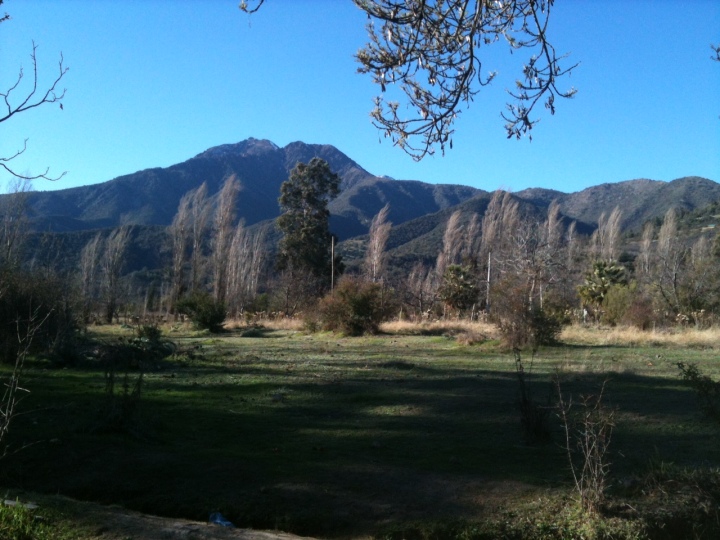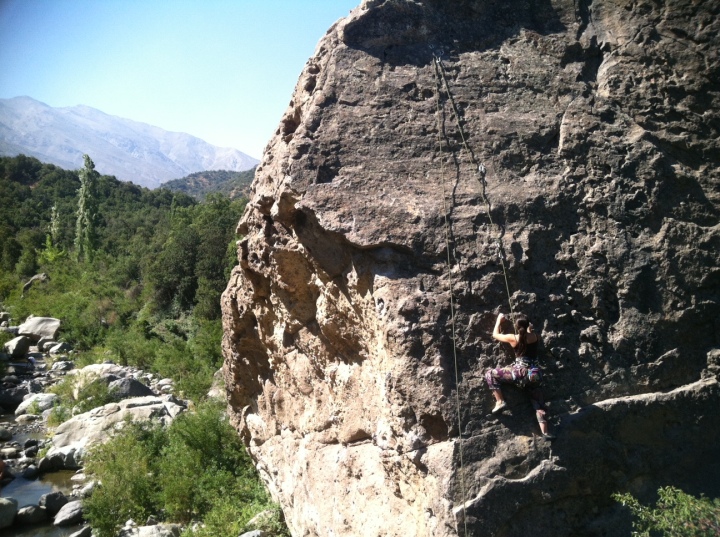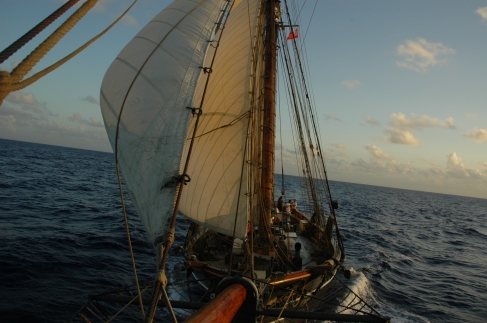Writers, parks and returns
A round-up of sorts.
A return to Chile, and maybe I’ll just begin to write about by returns, which happened a few weeks ago. I’ve now surpassed my goals for last year: sailing, hiking, Parque Andino Juncal, emotional and physical improvement.
And here I am in Chile for a reporting trip for the month of July. Among the pending items are the spring at Parque Andino Juncal. I met with a friend at his home in Pirque. Along with his wife we discussed ambitious ideas, talking late into the night about plans and dreams for the Aconcagua River headwaters. I awoke to clear skies, and Cerro Purgatorio in the distance, where my friend and his wife climbed for the winter solstice, as they do every year.
I’m thinking of Roberto Bolaño’s 2666, published in 2004. A book about one writer and four academics and lauded by critics worldwide, I am more astounded by the 20-line sentences that feel long only as one approaches the last few words, which wrap up those last 30-seconds of your life with swift, assured, surprising prose.
It is nothing like Martin Eden, written in 1909 by Jack London, which is a story about just one writer. The writer and intellectual works his way up from ignorance and lack of formal education to surpass all those around him. He leaves work as a sailor before the mast to toil with single-minded focus as a writer, a writer whose work transcends all else, whose work is an expression of beauty and has transformative effects upon the culture in which he lives. Of course no one cares about what he has written, until they do, and he becomes rich and famous. At that point the opinions of the fawning, herd-like mass is nothing but disillusionment to Eden and he sets off in a new direction.
The New York Times Literary Supplement had this to say about Bolaño:
“There are no defining moments in 2666. Mysteries are never resolved. Anecdotes are all there is. Freak or banal events happen simultaneously, inform each other and poignantly keep the wheel turning. There is no logical end to a Bolaño book.”
I’m only 75 pages into Bolaño’s’ 1100-page final work, finished just before his death, “that explores 20th-century degeneration through a wide array of characters, locations, time periods and stories within stories,” according to Wikipedia writers.
Whatever I will write or live on this page, of course, will never reach these heights. I can only describe what I see, feel, or hear.
This will be focused on my exploration of the Chilean craft beer industry, and, beginning on Thursday the trails of Parque Patagonia, a 200,000-acre conservation initiative 1,200 miles south of where I am now.
Auspicious arrival to Chile
And I’m back in Chile. Amazing. The culmination of goals I had set for myself, a pre-mid-life bucket list perhaps, after quitting my job in August. Thank you to all those people. You know who you are…who helped me get here.
There was the 1,500 nautical mile trip aboard the replica of the slave ship Amistad from Mass. to Puerto Rico. Then the double-handed sailing journey with my friend from Jersey City to Block Island, Rhode Island and back! Another sailboat delivery, and, a five-day solo backpacking trip through the Catskills.
My body took a beating, but survived. And on Saturday I arrived back in Santiago, a place I hadn’t visited since 2007.
I am here now to write about the amazing developments happening here in environmental conservation, adventure sports and mountains.
This will obviously include work on the development of a private conservation initiative on a 30,000 acre property in the Central Andes owned by my family and operated by my aunt called Parque Andino Juncal.
I lived here for nearly four years, and is the reason for this blog. It was a journey seen through unique eyes. My mother’s family had established themselves in Valparaiso from Australia in the early 1900s, and my father had written several books uncovering the sordid calculations of terror by the military dictatorship.
I was fascinated by the cultural changes and morphing of the people as the lingering shell of repression of cultural identity imposed by the 17-year dictatorship eroded away.
But I became jaded by the constant negativity by people in Santiago, a sense of constant profiteering by the country´s business class and frustration with my own goals.
And now Chile is post-Gothic, post-“buena Naty” (NSFW, look it up), post-Pokemon, post-massive student demonstrations and into the second, count it SECOND, term of Michelle Bachelet, the daughter of an assassinated military officer and the first woman president in Chile.
She will be inaugurated in March.
How much have things changed. How much does it matter? Will my constant analysis and tendency to focus on negative give way to seeking out what is positive? I think so.
And let me tell you of these positive things.
Within 24 hours of landing I was en route to nearby Cajon del Maipo to go rock climbing with nine nearly complete strangers. A few beers Saturday night turned into an invite to go climbing at 9 am Sunday morning. There would be eight Chileans and an American named Joshua.
The rock, called Piedra Rommel, was covered in climbers. The two 45-foot-high sandstone boulders along the river had some 20 routes coming off of them, ranging from the easiest to most difficult. There were women, men, children and adults clambering up and over this rock.
We set up camp nearby in the Mediterranean scrub brush, and proceeded to spend the Sunday afternoon drinking beer. Cries of successful summits, or agony as grip was lost and adrenalin surged in the moment of a fall, rang out past 8 p.m. That night I learned the art of grilling beef and pork, vegetables, potatos, and became close companions with the Chileans.
They were fountains of optimism, laughter, generosity and entrepreneurship. Oliver, a photographer, Pablo, a magician, Laucha, runs three small businesses, Valentina, works at an insurance company but wants to establish a program promoting healthy conversations around sex and sexuality. Is she serious? In conservative Chile? She was optimistic.
The next day was cliff jumping into a water hole, beer drinking and napping in hammocks or in the cool shade of a giant boulder next to a river.
And three days after I arrived it started it was over.
Now, I am off to Juncal for a busy week. I will spend three days with a glaciologist studying the curious life of a rock glacier at 10,000 feet. Then I will welcome a group of biologists from Bolivia, Argentina and elsewhere who have come to visit the park. There is also a change of park rangers to oversee and host of other tasks to get a better sense of how this park runs.
And then in a couple weeks, maybe a little (or a lot) of sailing in the most competitive and extravagant regatta in Chile, the Regata de Chiloe.
I’ll be posting regularly on Chile From Within with photos and video. Stay tuned.
Birds of the Sea
It came from far away, the jet black bird that landed and subsequently died in Parque Andino Juncal, near an altitude of 3,000 meters or around 9,000 feet.
This little bird was different than the other birds in Juncal.
It was streamlined, not colorful, round or compact like the birds that nibbled on bugs and seeds and crumbs of passing hikers or the torrent ducks who made their life in the whitewater of the rushing Juncal River, or the small flocks of green parakeets that fluttered, chattering, along the dusty dirt ledges that led down into that river.
According to an ornithologist who later examined it, the bird was a sea-going species that had become disoriented, maybe in a storm, or in a stream of high-altitude, fast-moving air that had deposited it, exhausted and starving, near a dusty rock in the Central Andes Mountains. It later died.
I hadn’t thought much more of it. My connections to Juncal had waned over the years as a reporter in the industrial and human-centered environment of Newark, New Jersey. And my emotional connections to the 30,000 acre private conservation initiative had become stale as my physical relationship to it had become a thing of my past life in Chile.
And then I quit my job, and I got on a the Amistad tall ship and ended up deep on the Atlantic Ocean, going through and beyond the locations vaguely present in the popular understanding of the sea, Georges Bank, the Hudson Canyon, the Bermuda Triangle, the Gulf Stream.
At night the air became fragrant and fecund, blowing gently across our cheeks as we ambled along towards Bermuda and then Puerto Rico.
It smelled like Juncal. There at the refuge called Los Hornitos, the place where the dusty road ends and visitors spend their first nights, some in a tent, or in the open air, or inside one of the two stone and mud structures, the smell becomes rich like the earth.
More often than not, in the morning, a dry wind blows hard from the border with Argentina and the glaciers along the border rushing into the Aconcagua Valley. In the afternoon the direction is reversed.
In the evening the air is quiet. And then, if one stays up particularly late, or wakes up during a dream, gets outside their tent or wherever they are sleeping, they will find that a humid, rich and temperate air has settled there.
Often late night air needs to braced against. This air is inviting and warm. This air was just like in the north Atlantic Ocean in August.
Maybe it was this air this bird was brought to.








1 comment